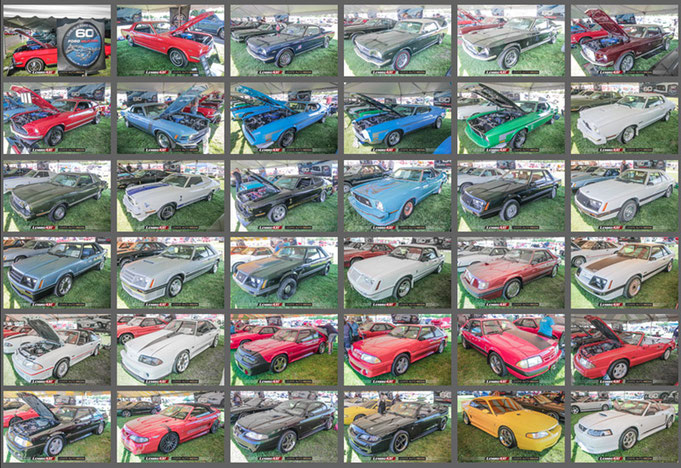2024 CARLISLE FORD NATIONALS
THE 1974-1978 MUSTANG II GENERATION
GOODBYE BIG BLOCKS and powerful engine, HELLO TO FUEL ECONOMY AND HANDLING!

EDITED BY ALAIN LEMIRE
PUBLISHED ON OCTOBER 29, 2024
I
n 2024, the Carlisle Ford Nationals put the dishes in the big ones to celebrate the 50th anniversary of the small Mustang II. Ah, 1974! A time when the trouser bottoms were as wide as elephant’s feet and moustaches well stocked.
The Mustang II landed in style, sneaking between the fuel-hungry giants. And while some were crying at their gas bill, the Mustang II was running on the asphalt, light as a feather.
THE LEE IACOCCA'S NEW VISION FOR THE MUSTANG
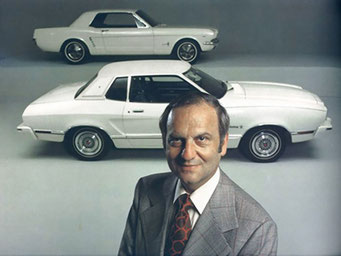
Lee Iacocca, the maestro of the Mustang, orchestrates a return to the roots for the 2nd generation. With a magic wand, he awakens the souls of the first Mustangs.
He realized that the early 1970s Mercury Capri with its 6-cylinder engine was the most sold imported car in the US, inspiring Iacocca to follow the same mechanical path with a new generation of
Mustang. And here it is, the "pony car" is back at full speed, ready to win new hearts in America and Europe, as this will be the last generation of Mustang to be sold new before its return in
2015!
It is a Mustang for young people, more economical on the gasoline, more maneuverable than the big Mustangs 1971-1973 and less powerful because you do not need 300 HP engine to make a Sunday ride!
The engines of the Mustang II started from the 88-horsepower Lima 4-cylinder in-line, moving from a 105-horsepower V6 to a 140-horsepower 4.9-liter V8.
THE RIGHT CAR AT THE RIGHT TIME...

When the Mustang II came out of the hood, the world didn’t know it was going to be hit in the face by a fuel shortage from the 1973 oil crisis. But now the prices at the pump started to
climb. And who was laughing behind the wheel? The owner of the Mustang II, of course!
Thanks to his moderate thirst, he became the darling of motorists. We can say that this dear Iacocca had smelled the right shot!
And who would have thought that a trio of angels detectives could make the sales of the Ford Mustang II skyrocket? Thanks to Charlie’s Angels, the Cobra II and Ghia models driven by Farah
Fawcette and Jaclyn Smith became the stars of the time, proving that you can be beautiful and powerful at the wheel. Sales exploded in 1976 (about 25,259 units for the Cobra II), a real master
stroke of Ford!
1974, a start OF A global PETROL crisis and WITH A PRESTIGIOUS AUTOMOTIVE award

The all-new Ford Mustang II had been celebrating its first year of an unexpected generation with the Motor Trend Magazine’s Car of the Year award.
The picture opposite shows the four members of the Mustang II family in 1974, namely:
• The white entry-level Mustang base coupe
• Mustang 2+2 fastback with brown hatchback
• Blue luxury coupé Mustang Ghia with white roof
• Mustang Mach 1 in grey and black
The organization of the models follows in little detail the preceding generation (1971-1973). The Ghia version is the worthy replacement of the 1969-1973 Grandé, while the Mach 1 takes its visual
pace of the year 1970, without V8 engine for 1974. A hatchback fastback version will appear on a production Mustang for the first time inspired by the 240Z and other small imported sports
cars.
The sales figure in 1974 is 385,993 units, which is almost 3 times more than in 1973.
The images below present you the dealer brochure of the time.
1975, the return of v8 engines under the hood of Mustang
With a year behind the belt, the Mustang II needed more power to not fade too much in power.
The Ghia version sees its vinyl roof take more importance and thickness. As for the other versions of the Mustang II, there is so much "no changes" that some photos from the 1974 brochure are
reused in 1975, such as the red Mach 1, the 2+2 fastback with brown hatchback, and the beige coupe.
Sales in 1975 were 188.575 units, almost half the 1974 figure.
The images below present you the dealer brochure of the time.
THE COBRA II 1976, A SPORTY AND RETRO look OF THE 60’S

Let’s start the 6 Mustang II overview of the year 1976 with the favorite Mustang II of Farah Fawcett, the Cobra II 1976 black and gold. It is a rather original look that the owner offered
us. The 2 others were blue and white Cobra II, the 2 other body colors available on this model.
The Cobra II was powered by a 4.9-litre V8 with 140 horsepower, the largest block offered on the generation of Mustang II.
The special features of the Cobra II appearance group that began in 1976 are the Le Mans-style decorative stripes popularised on Shelby American Cobras during the 1960s and the lateral decorative
stripe with the inscription “COBRA II” in large letters, not forgetting the drawing of the cobra affixed with stickers on the wings.
3 color combinations were available on the Cobra II either white with blue stripes, blue with white stripes and black with gold stripes.
It is worth noting the addition of a front deflector and a rear spoiler, its alloy wheels adds to the sporty look of the car. Its appearance in the Charlie’s Angels series help bringing a higher
success than expected by Ford in terms of sales for this model with an eye-catching look.
THE 1976 STALLION, a reminder of the past in motor racing
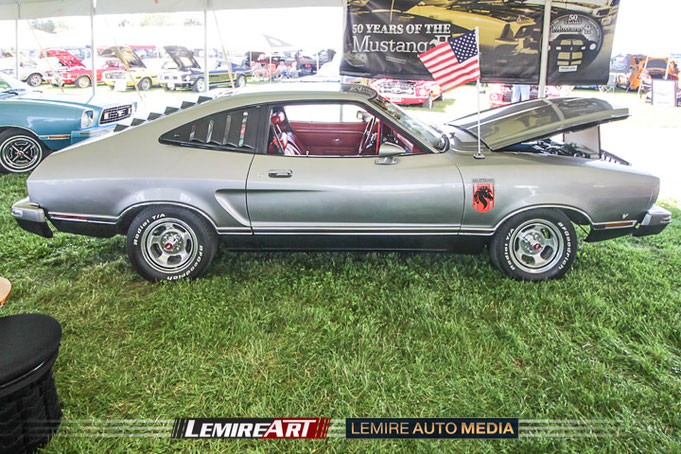
The 1976 Mustang Stallion stood out for its dark, sporty look: black trim, a grille without an emblem and black body bottoms. Although often associated with black and silver, it was
available in several bright colors including Silver Metallic, Bright Red, Bright Yellow, Polar White, and Silver Blue Glow.
With this model, Ford wanted to revive the flame of performance enthusiasts who missed the big V8 and the muscular spirit of old Mustangs. The car has a sticker on the front wing reminiscent of
the Shelby Terlinga. Its 5-hole aluminum wheels were very trendy at the time on the Mustang II.
This model was only produced in 1976 as a coupe and fastback, was less known than the Cobra II and about 1,942 coupes were produced.
The unit of the Stallion of the Mustang II seen in Carlisle was Silver Metallic with red interior was the most beautiful color combo.
The Ford Mustang II Stallion is the perfect embodiment of the rebellious spirit that lies in every Mustang.
1976, 2 new products to shake up sales
The Cobra II in Shelby’s look and the Stallion inspired by the Mustang Terlinga hired by Shelby American in Trans Am series in 1967, 1968 were the 2 big new arrivals of the 1976 model year. Another novelty is the appearance of the "tu-tones" option on the entry-level Mustangs. This option was to have a section of another color under the pleats of the bodywork bottoms for a customizable look according to the colors chosen.
Sales in 1976 were 187,567 cars, maintaining the previous year’s level of sales despite the arrival of 2 sporty-looking versions of the Mustang II.
The images below present you the dealer brochure of the time.
THE COBRA II 1977, WITH SOME RENEWED COLORS in 1977 1/2

In addition to design elements such as a black grille, black running mirrors, louvers on the rear windows, a rear spoiler, and a hood with an unfunctional air intake, the Mustang II in
version Cobra II will take many colors in 1977 1/2 with new 3 colors decorative strips following the disco trend.
There were four possible body colour and trim combinations on the Cobra II from 1977 1/2 model year to the end of production generation in 1978:
• White with 3 color red stripes
• White with 3 color green stripes
• White with 3 color blue stripes
• Black with 3 color gold stripes
On the exhibited car, you can see a white Cobra II with red decorative bands outlined by 2 different orange tones.
The interior of the car is red which harmonizes well with the exterior decoration. Ford wanted to remind the world that the Mustang did not loose its sporty soul.
About 21% of all Mustang hatchbacks sold in 1978 were Cobra II models.
Production of the Cobra II in 1978 dropped to 8,009 units, well below its peak of 25,259 units in its first year.
THE 1977 MODEL YEAR, a transition for the cobra ii
Following the disappearance of the Stallion version, the Cobra II will be offered in red with white stripes for early 1977. It will also be the occasion for Ford to introduce the T-Top roof for the first time on a Mustang. But only the fastback hatchback version will inherit it. The Cobra II will receive new disco-inspired decals in the middle of the year.
Sales in 1977 were 153,173 units, a drop of 20,000 units compared to 1976. The sales brochure was more complete in terms of pictures and page numbers than in previous years
The images below present you the dealer brochure of the time.
THE MACH 1 2+2 1978, beaten by cobra II's sales

The 1974 Mustang Mach 1 2+2 marks a turning point with the arrival of a hatchback bodywork seen on a prototype Mach 1 back in 1968 and 1970. While temporarily abandoning the V8 in 1974, it retains its sporty look and stands out with specific equipment including a black stripe on the back of the car and a specific Mach 1 lettering recalling the look of the 1970 version.
A rare black Mach 1 2+2 fastback model of the Mustang II was presented at the Mustang II 50 Years exhibition held in Carlisle. The Mach 1 is a model less often seen in
exhibitions because it was replaced by the more exuberant and popular Cobra II from 1976. This can be seen from the estimates of sales figures from 1974 onwards:
• 1974: Approximately 20,000 units.
• 1975: Approximately 13,000 units.
• 1976: Approximately 9,000 units.
• 1977: Approximately 6,000 units.
• 1978: Approximately 5,000 units.
Released in 1974, the Mach 1 was the high-performance version of the Mustang II with a... 6 cylinder engine of... a low 105 horsepower. A version of the 5.0-litre V8 will be installed in Mach 1
from 1975 to 1978.
In 1975, it introduced options such as the Rallye package, which included a Traction-Lok differential, 195/70 BWL tires, an additional cooling system, and a competition suspension.
In 1976, the Mach 1 remained a sports version of the Mustang II, but it was joined by the more appearance-oriented Cobra II.
The 1977 model included improvements such as a grille with more pronounced horizontal bars, a front spoiler, and four-way adjustable front seats.
The low sales of the Mach 1 compared to the Cobra II had killed the model at the end of the generation in 1978, all due to a beautiful Californian actress, star of a popular series!
THE 1978 MUSTANG II COUPE, A nostalgiC LOOK
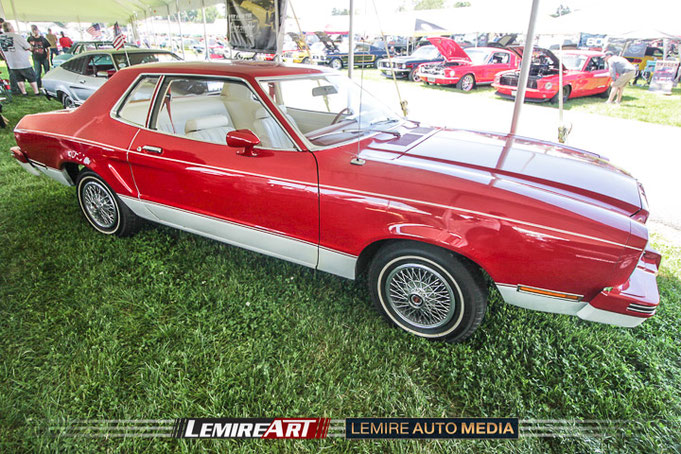

From 1976, the Mustang II featured a number of customization options. The bi-tone paint called “Tu-Tones” allowed owners to create a custom look.
There was a 2-colour cut of the 1978 Mustang II. It was red with a white bottoms. Its interior was also white.
This car reminded me of the Olympic Edition that we had in Canada whose colors were reversed, the white body, the red bottoms and the interior, an exclusive on this commemorative edition. Pinto
and Maverick were also produced in this edition.
the 1978 KING COBRA, the royalty on wheels
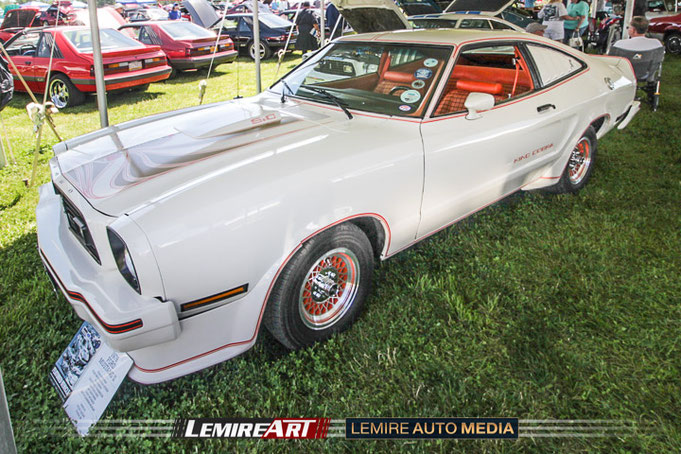
In 1978, Ford launched the King Cobra version, a special edition of the Ford Mustang II, designed to mark the end of this pony car generation, and a disco star-like car ready to seduce
sports car fans. Facing the Pontiac Trans Am, Rocky Balboa’s favorite car, Ford takes out boxing gloves and replicates with this car that combines style and design, shaking up the
market.
Result?
A legendary special edition, confirmed by five dazzling units that I saw in 2024 in Quebec City and in Carlisle.
Aesthetically, the car with an exclusive front deflector, fine pinstripe lines of colors skirting the body and a stylized cobra on the hood in the manner of the Trans Am bird, not to mention the King Cobra lettering affixed to the doors, had the package to meet Pontiac.
Here are some interesting details about the car:
• The performance of the 5.0-litre V8 at 139 horsepower was modest, with a top speed of approximately 108 mph and an acceleration from 0 to 60 mph in about 11
seconds.
• The King Cobra was limited to 4,313 units, making it a rare and sought-after model among collectors.
• Sold as a package at a price of US$1,277 to be added to the car price.
• The 1978 Ford Mustang King Cobra was available in 8 different body colours: red, yellow, orange, silver, black, brown, blue and white.
• In addition, there were 4 graphic stripe options: red and black, orange and gold, red and black, and blue and light blue.
• The stylized spoke wheels with thickness color matching the car graphics.
1978, the GENERATION swan song with an exclusive edition
It is with 6 models of the Mustang II in the catalog that the career of this generation of the favorite American pony car will end.
But it won’t be without a new version with a spectacularly spicy look called the King Cobra! Although it sold around 5,000 units, this Mustang will not exceed 200,000 units.
Sales in 1978 were 192,410, a good 40,000 car increase over 1977.
The images below present you the dealer brochure of the time.
THE LAST vroom
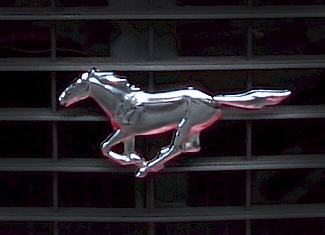
The Mustang II is like good wine, they improve with age! The generation that grew up with them now cherishes them as youth treasures.
And then, with the prices of the old ones flying away, these little Mustangs become the stars of the car ball.
They have the chic to captivate the eyes and open the wallets of nostalgic!
Admit that this generation of Mustang offers Mustangs visually attractive in terms of body colors as the 2 Ghia model seen at the 2024 Carlisle Ford Nationals of the first years
of yellow color with vinyl brown roof or forest green metallic added with golden pinstripe, and a forest green vinyl roof!
For my part, I remember drawing these Mustangs in high school.
The Mustang II, a landmark in American automotive history in the 1970s, proves that the icon can evolve without losing its essence of style and freedom.
want to see more...
Have a look at some Facebook post links of the 2024 Carlisle Ford Nationals!
A publication in the form of a Facebook photo album of one of the main attractions, 60 Mustang of the 60 years of the Ford Mustang at the 2024 Carlisle Ford Nationals.
More links of custom car and event articles released in 2024!
this page'S sponsor space...
A personalized automotive portrait signed by Alain Lemire offers a unique way to celebrate and immortalize your beloved vehicle.
The high-end printed printed piece of art thus reflects your special bond with it, prompting praise and questions from visitors about the work, a daily source of inspiration,
recalling your passions and successes.
about lemire auto media'S EDITOR

Since 2014 from Laval, Canada, Alain Lemire has managed a specialized website that shows his passion about classic, modern, and exotic cars and write about their history.
An image creator specialist
As a photographer and automotive portraitist, he uses his artistic knowledge to create stunning images restoring the ambiance of a world-class nationals US events, prestigious Concours d'Élégance, and auto shows.
An invitation to join the community
An invitation is made for you to fill the Lemire Auto Media newsletter inscription form on this page footer and follow when new articles on events, private vehicles, and museums related to his passions while on various trips will be published.



















































































